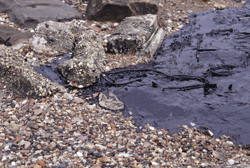Stressing bacteria for pollution treatment
The EU-funded BACSIN (Bacterial abiotic cellular stress and survival improvement network) project investigated the environmental survival regimes of a number of bacterial strains with good catabolic potential (so-called bacsins). Systems biology, single cell microbiology, classical genetics and modelling all contributed to a holistic picture of bacsin biology under stress. Bacterial strains were selected on the basis of target pollutants including alkanes and chlorophenols. Their preferred ecological niches were tested to assess behaviour under a range of exposures and environments. Membrane changes, synthesis of compatible solutes or operation of parallel and redundant metabolic pathways were all active in the microbes' survival arsenal. Microcosm studies using plant leaves, plant roots, soils, sediments, marine beaches, biofilms and reactors showed clearly which strains have superior survival ability. Emphasis was placed on formulations that would enable the microbes to fulfil their degradation function. Site tests involved a catabolic gene chip and corresponding protocol developed by BACSIN. After extensive testing at varying locations and by different operators, two areas of decontamination were successful. Rhizoremediation using a combination of planting and inoculation with bacsins was a successful strategy for petroleum-contaminated sites. Vermiculite-formulated bacsins gave good degradation results in chlorophenol-contaminated soil. Surprisingly, more abundant strains isolated at polluted sites presumed to be superior survivors were not so superior after all. However, most of the preselected bacsins survived and aided contaminant degradation during field trials. The conclusion is that pretesting will reveal the most appropriate bacsin for survival and aid in contaminant degradation. Particular highlights for dissemination included the project website, an international student summer course in July 2011 in Lausanne and a final international symposium on rational use of bacteria for bioaugmentation in April 2012 in Amsterdam. Around 60 papers have been published in peer-reviewed journals. These findings, together with the isolation of natural bacsins from environmental sites, stand to improve the exploitation of bacterial catalytic activities for targeted pollution treatment. Implementation of the Bacsin findings at contaminated sites could improve biodegradation with obvious benefits for the environment.
Keywords
Bacteria, stress survival, pollution treatment, bacsins, environment







